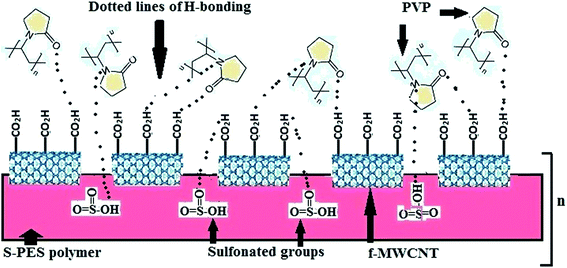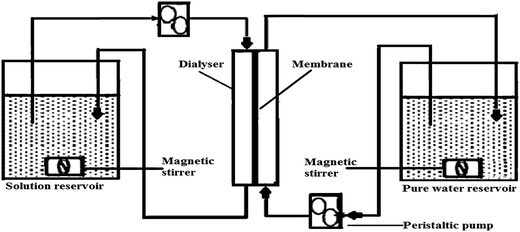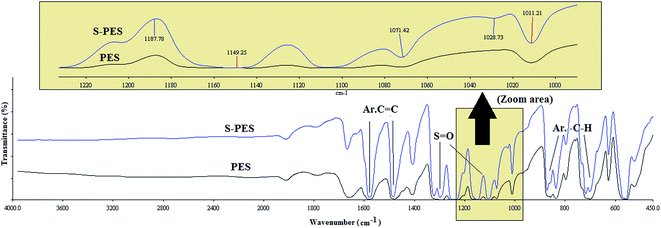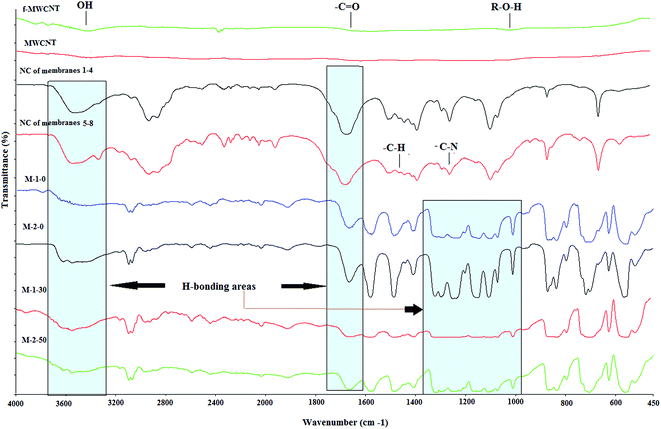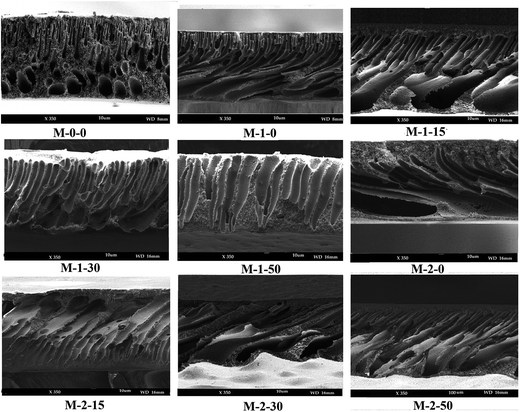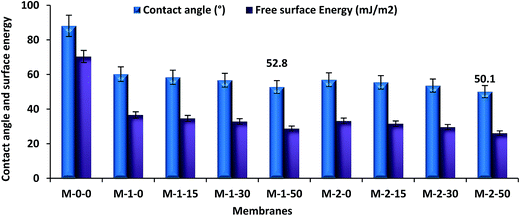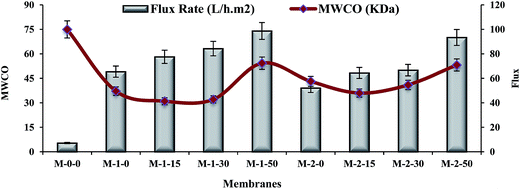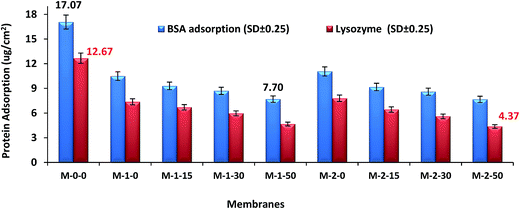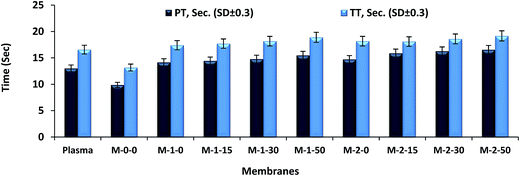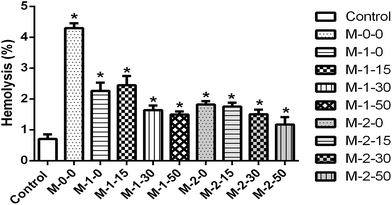Fabrication and evaluation of polymeric membranes for blood dialysis treatments using functionalized MWCNT based nanocomposite and sulphonated-PES
Muhammad Irfan,
Ani Idris *,
Rozita Nasiri and
Javad Hamzehalipour Almaki
*,
Rozita Nasiri and
Javad Hamzehalipour Almaki
Institute of Bioproduct Development, Faculty of Chemical and Energy Engineering, Universiti Teknologi Malaysia, 81310 UTM, Johor Bahru, Johor, Malaysia. E-mail: ani@cheme.utm.my; Fax: +60 075588166; Tel: +60 75535603
First published on 20th October 2016
Abstract
The use of polyethersulfone (PES) based membranes for dialysis therapy is increasing, but the transformation and adsorption of blood proteins, destruction of red blood cells, and thrombosis responses against PES membrane can raise severe blood reactions affecting the rate of morbidity and mortality of hemodialysis (HD) patients. In this work, the performance and biocompatibility of PES membranes were improved by sulfonation and nanocomposites (NCs) additives. Acid functionalized multiwall carbon nanotubes (f-MWCNT) and polyvinylpyrrolidone (PVP) were used for NCs preparation and then they were incorporated into sulfonated-polyethersulfone (S-PES) based membranes. The hydrophilic part of f-MWCNT contributed to the –COOH and –OH groups, whereas sulfonated polymer provided the –SO2H group in the membrane composition. The formulated HD membranes were characterized by FTIR, FESEM and contact angle. The AFM was used for the estimation of the surface roughness and surface profile studies, whereas flux rate, and rejection rate was also determined. The biocompatibility results revealed that sulfonated-NCs based membranes had reduced 55% (BSA), 65% (lysozyme) adsorption and 74.80% hemolysis process. It also demonstrated higher clotting time of prothrombin (PT), thrombin (TT), activated partial thrombin time (APTT), plasma re-calcification time (PRT). The dialysis results indicated that, compared to the pristine PES membrane, the clearance ratio of lysozyme, urea and creatinine solutes increased up to 32.4%, 59.2% and 57.3%, respectively. Thus, the blending of S-PES and NCs in the PES membrane highly improved the biocompatibility and removal ability of uremic solutes.
1 Introduction
Hemodialysis (HD) is a vital medical therapy to eliminate uremic toxins in the blood of a patient with severe renal disease. The chief constituent of a hemodialysis instrument is a semipermeable membrane, whose chemical composition has great effect on a patient's health either in terms of membrane biocompatibility or uremic waste removal.1 Nowadays, the HD membranes are manufactured from synthetic polymers in which 93% are derived from the parent polyarylsulfone family, with 71% from polysulfone (PS) and 22% produced from PES.2 The use of PES based dialyzers is increasing as it is considered a bisphenol-A free membrane than PS.3PES is chemical resistant thermoplastic, hydrophobic in nature and extensively employed in medical devices of blood contact applications. Due to its hydrophobic nature the biocompatibility of PES membranes need to be further improved using different additives and modification methods as reported in many studies.4 Among the various modification techniques, the blending of hydrophilic additives is the simplest method and PVP is broadly utilized to improve the biocompatibility of PES membranes. PVP is highly hydrophilic, amphiphilic, biocompatible and pore forming agent, but, it is water-soluble and swells in aqueous environments and is immiscibility with hydrophobic PES. The HD membrane performance could be affected when the PVP was eluded during dialysis, which might cause severe health problems of the relevant kidney patients.5 To improve the compatibility of PVP to PES, binary,6 ternary covalent and composite blocks of PVP were synthesized in which one block was hydrophobic in nature that made hydrophobic–hydrophobic interaction with PES polymer.7,8
The rapid evolution of nanotechnology has amplified the decision of applying nanomaterials in biomedical application such as bio-sensing, bio-imaging and cancer therapy diagnoses, but they are not well explored in hemodialysis membrane systems.9 In recent years, the multiwall carbon nanotubes (MWCNTs) have shown outstanding potential in biological systems and membranes. The properties of MWCNT can be easily improved or upgraded by the attachment of different functional groups.10,11 The MWCNTs are highly hydrophobic and non-polar material and its direct use without surface modification or surfactants may cause agglomeration and poor dispersion in membrane matrix, leading to defective product. Acid treatment is the simplest chemical method to create the polarity and attachment of the hydrophilic functional groups (carboxyl and hydroxyl) with MWCNT surface. This hydrophilic–hydrophobic nature of acid functionalized f-MWCNT provide a dual character, that can attract and bind both hydrophobic and hydrophilic types of chemicals by π–π stacking and dipole–dipole interactions, respectively.12
PVP was also reported as a surfactant with carbon nanotubes that improved its disperse-ability and reduced the agglomeration in different solvents.13 Therefore, in this work, PVP and f-MWCNT based NCs were synthesized and blended with PES so as to improve the dispersion properties of MWCNT but also enhance the biocompatibility of resultant membranes.
The biocompatibility of PES HD membranes does not depend on a particular factor; hence different techniques are utilized to improve this property. A number of researchers have focussed to chemical modification of PES polymer and others have used different additives.14,15 The use of both methods polymer modification and blending of additives together have attracted much attention to improving the PES biocompatibility and uremic solute removal ability.
Sulfonation is a chemical modification method of the PES polymer that enhanced its biocompatibility and hydrophilicity.7,16 There are few studies, who reported that sulfonation of polymers had increased the anionic character on the membrane surface and the presence of anionic functional groups in the polymer reduced the blood and membrane interaction via steric repulsion and showed good anticoagulant activity.15,17 Cheng et al.18 found that SPES polymer reduced the contact activation of blood, whereas Wang et al.,15 reported that blending of SPES reduced the protein adsorption and elevated the blood coagulation time.
Up till now various works are published that report the performance of PES membranes with different surface modification. However, none of these reported work are specifically focused on the performance enhancement of PES membranes using sulfonated PES and blending of f-MWCNT/PVP based NC's together in the application of HD. In the current work, PES was modified using sulfonation method and then blended with f-MWCNT and PVP based NCs as additives. The various ratios of SPES to NCs were utilized as mentioned in Table 1 and flat sheet membranes were casted. The bonding chemistry of HD membranes was characterized by FTIR spectra and its diagrammatic presentation is shown by Fig. 1. The FESEM and CA studies were used for cross section and hydrophilicity judgments of the membranes. The AFM technique was adapted to observe the surface profile study and surface roughness, whereas the HD membranes were also characterized in term of flux rate, rejection rate, MWCO, protein adsorptions and blood hemolysis and clotting time experiments. The dialysis performance was investigated by model solution of uremic solutions containing urea, creatinine and low weight protein lysozyme.
| Memb. (M-CNT-SPES) | Step 1 | Step 2 | ||||
|---|---|---|---|---|---|---|
| Nano-composite | ||||||
| f-MWCNT | PVP | DMF | PES | S-PES | DMF | |
| M-0-0 | — | — | — | 18 | — | 82.00 |
| M-1-0 | 0.1 | 3 | 20 | 18 | — | 58.80 |
| M-1-15 | 0.1 | 3 | 20 | 15.3 | 2.7 | 58.90 |
| M-1-30 | 0.1 | 3 | 20 | 12.6 | 5.4 | 58.90 |
| M-1-50 | 0.1 | 3 | 20 | 9 | 9 | 58.90 |
| M-2-0 | 0.2 | 3 | 20 | 18 | — | 58.80 |
| M-2-15 | 0.2 | 3 | 20 | 16.2 | 1.8 | 58.80 |
| M-2-30 | 0.2 | 3 | 20 | 14.4 | 3.6 | 58.80 |
| M-2-50 | 0.2 | 3 | 20 | 9 | 9 | 58.80 |
2 Materials and methods
2.1 Materials
The porous flakes of PES (Ultrason E6020P, molecular weight average 58k Dalton, mass density 1.37 g cm−3, 0.8% moisture and glass transition temperature 225 °C) were purchased from BASF, Germany. The lysozyme (14![[thin space (1/6-em)]](https://www.rsc.org/images/entities/char_2009.gif) 600 g mol−1), creatinine (MW 113.12 g mol−1), urea (MW 62.02 g mol−1) were arranged by Sigma Aldrich. Polyvinylpyrrolidone-K90 and BSA (67k Da) were purchased from Fluka, dimethyl formamide (average molecular weight = 80.14 g mol−1) and chloro-sulfonic acid were from Merck and the pristine MWCNT (length: 12 micron, average diameter: 10 nm) was from Chengdong (China).
600 g mol−1), creatinine (MW 113.12 g mol−1), urea (MW 62.02 g mol−1) were arranged by Sigma Aldrich. Polyvinylpyrrolidone-K90 and BSA (67k Da) were purchased from Fluka, dimethyl formamide (average molecular weight = 80.14 g mol−1) and chloro-sulfonic acid were from Merck and the pristine MWCNT (length: 12 micron, average diameter: 10 nm) was from Chengdong (China).
2.2 Sulfonation
In the sulfonation reaction, 20 g of PES was homogenized with 100 ml of concentrated sulphuric acid (98%) in a three-neck reaction flask with constant stirring at 500 rpm at room temperature. Then, 50 ml of chloro-sulfonic acid was added drop by drop to the PES solution with constant stirring at 800 rpm for 12 h at 10 °C. The SPES polymer was precipitated in cold de-ionized water after reaction optimization, separated by filtration and finally washed with deionized water until the pH ≅ 6–7.192.3 MWCNT functionalization, NCs and membrane casting
The acid functionalization of raw MWCNTs was used to develop the polarity and functional groups (–COOH and –OH) and also improve its dissolution in DMF solvent and introduces the binding sites on the nanotubes. The complete method of acid functionalization was reported in our previous study.20 Nitric (3 wt%) and sulphuric acid (1 wt%) was mixed in a flask and then 10 g of MWCNT was added and stirred at 110 °C for 24 h. After the estimating time, the deionized water was added to the solution and acid functionalized MWCNT was filtered through a 0.22 μm polycarbonate membrane, followed by washing and drying.21,22 Blending method was used for the NCs preparation in which PVP was first added to the solvent (DMF) in a round bottom flask by stirring at 500 rpm and then f-MWCNT was added slowly in various quantities as mentioned in Table 1 (step 1) and further stirred for 5 h.Modified microwave (MW) oven (model NN-5626F) was utilized for the synthesis of polymer solutions as described by Idris et al.23 Briefly, 18 wt% of PES and SPES polymers were blended together with NCs (f-MWCNT/PVP) as described in step 2 in Table 1. After heating in the MW oven (10 min, 85–95 °C) and further stirring (800 rpm) for 30 min without heat, the sulfonated-NCs based polymer solution was cooled and stored in the Scott bottles for 48 hours. The air bubbles were eliminated by gravity from the dope solutions. The flat sheet membranes were fabricated by means of the casting knife on the dust free glass plate with the thickness of 160–200 μm by the dry–wet method. After the post-treatment in the hot water bath (80 °C, 30 min), the membrane was ready for testing. The post treatment removed any excess un-reacted chemicals that might be present in the membranes.
In the Table 1, since the weight percentage of PES and PVP are same in all the formulated membranes, that's why, the name of each membrane, is mentioned by three fonts word, separated by hyphen (-), which belong to membrane, f-MWCNT and SPES percentage only. For example the name of the membrane M-1-15 represents “M” for membrane, 1 is 0.1 f-MWCNT and 15 correspond to 15 wt% SPES of total polymer weight. Similar, M-2-50 represents the membrane-0.2 wt% f-MWCNT and 50 wt% of SPES. Moreover, two types of membrane series are formulated, the 1st based on 0.1 wt% of f-MWCNT and 0–50 wt% of SPES polymer, whereas 2nd series contains 0.2 wt% of f-MWCNT and 0–50 wt% of SPES.
2.4 Characterizations
 | (1) |
 | (2) |
The surface free energy of interaction at the interface between the liquid and the membrane surface (−ΔGSL) was calculated using Young–Dupre revised equation (eqn (3)),
−ΔGSL = (1 − cos![[thin space (1/6-em)]](https://www.rsc.org/images/entities/char_2009.gif) θ)γTL θ)γTL
| (3) |
2.4.5.1 Statistics of surface roughness. The quantitative dimensions of surface roughness and its relevant parameters of FSM were examined by the (Park XE) AFM instruments. The contact mode was used for the scanning of the FSM having size 2.5 μm × 2.5 μm. The statistics table provides the information about the minimum, maximum, the average between the minimum and maximum heights, ten points average roughness, root-mean-squared roughness, peak-to-valley, kurtosis and skewness of the surface grains, corresponding to the scanned image of the membranes.
2.4.5.2 Surface profile (grain analysis). The image processing software (XEI-100) of the AFM was used for the quantitative determination of the surface profile all formulated HD membranes. In the surface profile, the perimeter, area, volume, length, radius, diameter and no. of grains of the FSM were determined by the grain analysis tab. The grains were detected from the scanned image of membranes via the watershed method (filter 0.5).26
 | (4) |
The same setup of the cross-flow cell was used to evaluate the molecular weight cut off by the solute rejection performances of the casted membranes. The BSA and PEG with different molecular weights (PEG 10![[thin space (1/6-em)]](https://www.rsc.org/images/entities/char_2009.gif) 000 and PEG 35
000 and PEG 35![[thin space (1/6-em)]](https://www.rsc.org/images/entities/char_2009.gif) 000) solutions having concentration of 1 g l−1 were used, whereas the rejection rate is estimated using eqn (5),
000) solutions having concentration of 1 g l−1 were used, whereas the rejection rate is estimated using eqn (5),
 | (5) |
2.5 Biocompatibility
 | (6) |
The human blood and its plasma were utilized to evaluate the hemocompatibility behavior of the formulated membranes. The human blood was collected into the sodium citrated (3.8%) vacuum blood collection tubes (3 ml) obtained from Thermo-fisher Co (blood to anticoagulant ratio 9![[thin space (1/6-em)]](https://www.rsc.org/images/entities/char_2009.gif) :
:![[thin space (1/6-em)]](https://www.rsc.org/images/entities/char_2009.gif) 1). The tube was shaken well to mix the blood with sodium citrate to avoid blood coagulation under sterile and cool conditions and used immediately within 24 hours. In order to utilize the donor's blood and the dissemination of its information in the scientific record, an informed consent was obtained from the donor who was a male of age 32 with no serious sickness in the background. The blood sampling procedure was carried out at the health care centre of Universiti Teknologi Malaysia (UTM). The medical advisory committee (ISO/TC 194) and clinical ethic committee of the Sultanah Aminah health care hospital Berhad, Malaysia in association with the Ministry of Health (MOH), approved this procedure under the Medical Device Act 2012 (Act 737 & 738) and the standard guidelines mentioned in ISO 10993-1:2009 documents.30
1). The tube was shaken well to mix the blood with sodium citrate to avoid blood coagulation under sterile and cool conditions and used immediately within 24 hours. In order to utilize the donor's blood and the dissemination of its information in the scientific record, an informed consent was obtained from the donor who was a male of age 32 with no serious sickness in the background. The blood sampling procedure was carried out at the health care centre of Universiti Teknologi Malaysia (UTM). The medical advisory committee (ISO/TC 194) and clinical ethic committee of the Sultanah Aminah health care hospital Berhad, Malaysia in association with the Ministry of Health (MOH), approved this procedure under the Medical Device Act 2012 (Act 737 & 738) and the standard guidelines mentioned in ISO 10993-1:2009 documents.30
For the test, the membrane samples (0.5 cm × 0.5 cm) were neutralized by immersing them in PBS solution (pH = 7.4) for 2 h and then dipped in the 500 μl of freshly prepared plasma from human blood and placed in oven for 30 min at 37 °C. The change in human plasma with respect to APTT, TT, PT, and FB were evaluated using Stago kits of CK Prest 2, thrombin 2, neoplastin 2 and fibrinogen 2, respectively.31
![[thin space (1/6-em)]](https://www.rsc.org/images/entities/char_2009.gif) :
:![[thin space (1/6-em)]](https://www.rsc.org/images/entities/char_2009.gif) 8. The 2 mg of the membrane sample was dipped into the 1 ml suspension of RBCs (0.2 ml diluted HRCs + 0.8 ml PBS) and incubated for 1 h at 37 °C, followed by centrifugation (10
8. The 2 mg of the membrane sample was dipped into the 1 ml suspension of RBCs (0.2 ml diluted HRCs + 0.8 ml PBS) and incubated for 1 h at 37 °C, followed by centrifugation (10![[thin space (1/6-em)]](https://www.rsc.org/images/entities/char_2009.gif) 000 rpm, 2 min). The UV-vis spectrometer was used to determine the absorbance and the hemolytic percentage (HP) is calculated using eqn (7),
000 rpm, 2 min). The UV-vis spectrometer was used to determine the absorbance and the hemolytic percentage (HP) is calculated using eqn (7),
 | (7) |
2.6 Dialysis of uremic solutes
The dialysis performance of selected uremic solute of the HD membranes was observed by single layer dialysis cell (Fig. 2), having total effective volume 10 ml and an area of 30 cm2 as described by Idris and Lee.32 The dialysis cell is separated into two compartments with their own inlet and outlet points and the membrane was placed between them. The 250 ml model solution of uremic solutes containing lysozyme (0.5 mg dl−1), creatinine (0.1 mg ml−1) and urea (1 mg ml−1) was dialysis against distilled water as dialysate. The high efficiency of dialysis was obtained when the dialysate flow rate was higher 2 to 2.5 times than a solute solution with the counter-current flow.33 The experiments were performed at 37 °C ± 1 for 4 h and 2.5 ml of the dialysis samples was collected for testing at intervals of 2 h. Bradford reagents were used for the determination of lysozyme via a calibration curve method, whereas urea and creatinine were estimated by Radox test kits supplied by All Eights (Malaysia Sdn. Bhd). The concentrations of uremic solutes are determined by eqn (8),
 | (8) |
2.7 Statistical analysis
For the obtained results of hemolysis and dialysis of uremic solutes (Section 2.5.3 and 2.7) the statistical analysis was performed. The Graphpad Prism 6.0 software was used, which expressed the data as mean (±SD) of three independent experiments. The multiple t-test analyses were executed and the significant data showed a p-value of less than 0.05.3 Results and discussion
3.1 Sulfonation and acid functionalized MWCNT
The degree of sulfonation of PES depends on different parameters including sulfonating solvent, sulfonating agent (SO3 or its complexes, oleum, chlorosulfonic acid (–ClSO3H)), reaction temperature, reaction time, and polymer concentration.34 In this work, the –ClSO3H was selected because of its simplicity and ease of use as sulfonating agent. The acid was added drop by drip at 10 °C and the DS of PES was controlled by the reaction time and the ratio of –ClSO3H and PES polymer. The sulfonation of polymer was verified by acid base titration and FTIR spectra. The titration results showed that the polymer had 23.61% of DS and 0.94 meq g−1 of IEC values of sulfonation.19,35 Fig. 3 represents the FTIR spectrum of PES and SPES membranes. For the PES polymer, the bands at 1249 and 1134 cm−1 were related to the asymmetric and symmetric stretching vibrations of S![[double bond, length as m-dash]](https://www.rsc.org/images/entities/char_e001.gif) O group, while the bending vibration of PES aromatic rings was visible at the peaks of 1480 and 1570 cm−1.36 At the 1134 cm−1, the broad peak of SPES was observed as compared to PES which was due to sulfonation process that enhanced the numbers and distribution of –S
O group, while the bending vibration of PES aromatic rings was visible at the peaks of 1480 and 1570 cm−1.36 At the 1134 cm−1, the broad peak of SPES was observed as compared to PES which was due to sulfonation process that enhanced the numbers and distribution of –S![[double bond, length as m-dash]](https://www.rsc.org/images/entities/char_e001.gif) O groups in the SPES polymer. Since the sulfonated group was detected between the “1000 to 1200 cm−1” absorbance ranges, thus this area was zoomed for the clear identification of the sulfonation group via the FTIR software. Successful introduction of the sulfonated groups was confirmed by the visible bands at 1011 and 1028 cm−1 attributed to the symmetrical stretch of the sulfonated groups, whereas bands at 1071 and 1187 cm−1 correspond to its asymmetric stretch. The sulfonated membrane also showed a prominent band at 1150 cm−1 corresponding to the –S
O groups in the SPES polymer. Since the sulfonated group was detected between the “1000 to 1200 cm−1” absorbance ranges, thus this area was zoomed for the clear identification of the sulfonation group via the FTIR software. Successful introduction of the sulfonated groups was confirmed by the visible bands at 1011 and 1028 cm−1 attributed to the symmetrical stretch of the sulfonated groups, whereas bands at 1071 and 1187 cm−1 correspond to its asymmetric stretch. The sulfonated membrane also showed a prominent band at 1150 cm−1 corresponding to the –S![[double bond, length as m-dash]](https://www.rsc.org/images/entities/char_e001.gif) O symmetrical stretch.37–40
O symmetrical stretch.37–40
The acid functionalization of pristine MWCNTs was used to develop the polarity and functional groups (–COOH and –OH) on its surface, which contributes not only to the creation of hydrogen bond or dipole–dipole bond with nitrogen and hydrogen atoms that are present in the PVP, but also with the sulfonated groups of the SPES polymer. The solvent solubility parameter was used for the selection of the appropriate solvent (DMF) for the proper dispersion of nanotubes and it is also reported that the dispersion of f-MWCNT is better than pristine MWCNT.39,41,42
FTIR was used to recognize the attachment of functional groups on the surface of f-MWCNT. In Fig. 4, the comparison of FTIR spectrums of f-MWCNT and MWCNT indicate that the new peaks developed in the f-MWCNT spectra at the 3300–3450 cm−1, 1690 and 1030 cm−1 corresponding to O–H of acid and alcohol, acid carbonyl (C![[double bond, length as m-dash]](https://www.rsc.org/images/entities/char_e001.gif) O) and primary alcohol (ROH), respectively.43 After the acid treatments, appearance of these peaks in the FTIR spectra of f-MWCNT confirmed the presence of –COOH and –OH groups.
O) and primary alcohol (ROH), respectively.43 After the acid treatments, appearance of these peaks in the FTIR spectra of f-MWCNT confirmed the presence of –COOH and –OH groups.
3.2 Nano-composite based sulfonated membranes
![[double bond, length as m-dash]](https://www.rsc.org/images/entities/char_e001.gif) O, –SO3H and –C–N polar groups. Thus, the presence of hydrogen bonding was confirmed by the FTIR analysis at 3500, 1650 and 1050–1370 cm−1.
O, –SO3H and –C–N polar groups. Thus, the presence of hydrogen bonding was confirmed by the FTIR analysis at 3500, 1650 and 1050–1370 cm−1.The investigation of surface free energy appears as a very important parameter to determine the wetting and spreading processes of other substances on the membrane surface and their interactions. Generally, the sum of the polar and dispersive components are used to evaluate the surface free energies of the membrane surfaces. The polar component, relates to the specific and non-specific interactions and the interactions other than the dispersive component, while the dispersion component estimates only from the London's effect, also known as dispersive interactions.51–53 The surface free energy of pristine membrane was observed 70.39 mJ m−2 that was highly reduced by the addition of S-PES and NCs up to 26.10 mJ m−2. The pristine membrane contained negligible amount of polar components that's why it showed hydrophobic behavior and high surface energy, whereas the addition of S-PES and NCs in the membrane formulation not only enhanced the polar components in the form of sulfonated, carboxyl, hydroxyl and pyrrolidone groups, but also improved the dispersive forces between PES and hydrophobic parts of NCs, which ultimately reduced the surface free energies of the corresponding membranes.
The CA of pristine PES membrane (M-0-0) was recorded as 88.1°, which was reduced in non-sulfonated NCs membranes (M-1-0 & M-2-0) to 60.2° and 57°, respectively. The reduction of CA values indicated that the blending process has effectively incorporated the NCs (PVP/f-MWCNT) in the membrane matrix. Fig. 6 also shows the further decline of contact angle (12–12.5%) with the increasing factor of sulfonation (0 to 50%) from M-1-0 to M-1-50 and M-2-0 to M-2-50. This trend suggested that as the degree of sulfonation increased the ionic effect in the membranes, which in turn attracted the water drops more strongly toward to them, causing low CA results. The amount of SPES polymer seems directly proportional to the increment of hydrophilicity and these findings are similar to the published works of Wang et al.14 Since the calculations of surface free energy of the membranes depend on the variation of CA results (eqn (3)), so as the CA values decreased the surface free energy of the membrane also minimised correspondingly, by the blending of SPES and NCs in the resultant HD membranes.
Table 2 represents the results of quantitative measurements of image statistics of the various parameters of surface roughness of all formulated membranes observed by AFM. The blending of NCs and SPES polymers altered the surface properties of the casted membranes and the accumulation of NCs seemed to be reduced from M-1-0 to M-1-50 membranes with the progressive increment of the sulfonation amount. The observation was in good agreement with the image statistics results of surface roughness (Ra) in Table 2, which depicts that the presence of NCs (M-1-0 and M-2-0) reduces the surface roughness (Ra) compared to the pristine membrane (M-0-0). Also, as the degree of SPES polymer increased the surface roughness parameter was further decreased and a smoother membrane was formed. A similar trend is visible in both SPES series with 0.1 and 0.2 wt% amounts of NCs. The progressive declined of Ra values showed that sulfonation of PES improved the distribution of NCs in the membrane matrix and the hydrophilic effect was increased. The surface roughness of M-1-50 (Ra = 2.68) is slightly higher than M-1-30 (Ra = 2.45), but its parameter like Rpv and Rz seems quantitatively equal to the M-1-30 membrane. The π–π stacking or hydrophobic–hydrophobic interaction of the nanotubes caused the MWCNT to accumulate, that was reduced by acid treatments and sulfonation.22,54 The acid treatment and sulfonation increased the hydrophilicity by the contribution of the –COOH, –OH and the –HSO3 group in the resultant membranes. These hydrophilic functional groups not only decreased the π–π stacking of MWCNT, but also improved its dispersion that was observed in terms of reducing the surface roughness parameters.
| Memb. | Min (nm) | Max (nm) | Mid (nm) | Rpv (nm) | Rq (nm) | Ra (nm) | Rz (nm) |
|---|---|---|---|---|---|---|---|
| M-0-0 | −20.82 | 16.40 | −2.21 | 37.22 | 5.64 | 4.57 | 33.86 |
| M-1-0 | −13.05 | 41.68 | 14.31 | 54.73 | 4.73 | 3.78 | 34.65 |
| M-1-15 | −11.00 | 22.19 | 5.60 | 33.19 | 4.00 | 3.17 | 29.77 |
| M-1-30 | −10.70 | 13.70 | 1.50 | 24.40 | 3.39 | 2.68 | 22.35 |
| M-1-50 | 1.11 | 22.58 | 11.84 | 21.47 | 3.09 | 2.45 | 20.05 |
| M-2-0 | −11.10 | 21.33 | 5.12 | 32.43 | 4.85 | 3.95 | 28.05 |
| M-2-15 | −12.49 | 17.58 | 2.55 | 30.07 | 4.73 | 3.82 | 28.26 |
| M-2-30 | −15.63 | 11.29 | −2.17 | 26.92 | 4.07 | 3.36 | 22.85 |
| M-2-50 | −17.43 | 17.44 | 0.01 | 34.87 | 3.80 | 2.85 | 29.42 |
| Std div. | ±2 | ±2.5 | ±0.5 | ±3 | ±0.5 | ±0.5 | ±3 |
| Memb. | Area (μm2) | Peri (μm) | Volume (μm3) | Length (μm) | Radius (nm) | Dia. (nm) | No. of grains |
|---|---|---|---|---|---|---|---|
| M-0-0 | 7.19 × 10−2 | 1.146 | 2.93 × 10−4 | 0.389 | 15.48 | 30.97 | 69 |
| M-1-0 | 5.88 × 10−2 | 1.041 | 1.98 × 10−4 | 0.354 | 13.34 | 26.69 | 80 |
| M-1-15 | 6.79 × 10−2 | 1.111 | 1.88 × 10−4 | 0.378 | 12.60 | 25.20 | 72 |
| M-1-30 | 5.95 × 10−2 | 1.015 | 2.59 × 10−4 | 0.343 | 15.51 | 31.01 | 74 |
| M-1-50 | 8.15 × 10−2 | 1.241 | 1.95 × 10−4 | 0.419 | 12.18 | 24.35 | 82 |
| M-2-0 | 6.25 × 10−2 | 1.068 | 2.21 × 10−4 | 0.363 | 13.93 | 27.87 | 76 |
| M-2-15 | 7.21 × 10−2 | 1.168 | 2.47 × 10−4 | 0.395 | 14.12 | 28.24 | 68 |
| M-2-30 | 7.42 × 10−2 | 1.187 | 3.37 × 10−4 | 0.398 | 16.42 | 32.84 | 67 |
| M-2-50 | 7.41 × 10−2 | 1.163 | 5.30 × 10−4 | 0.389 | 20.83 | 41.66 | 63 |
| Std div. | ±2.0 × 10−4 | ±0.02 | ±2.0 × 10−6 | ±0.003 | ±1.5 | ±3 | — |
Fig. 7 represents the MWCO and flux rates of the different formulated membranes, whose results show that the addition of NCs and SPES polymer not only increases the flux rate, but also decrease the MWCO. The flux rate of pristine PES membrane was 7.14 L m−2 h−1 and when NCs was added to the PES polymer (non-sulfonated membrane), the flux rates increased up to 65.5 L m−2 h−1 in M-1-0 membrane. Moreover, the blending of S-PES polymer in the PES/NC's based dope solution were resulted in a further increment of the flux rates (98.7 L m−2 h−1), especially in M-1-50 membranes. It was observed that the blended weight percentage quantity of SPES was directly proportional to the flux rate and high flux rate was obtained with the 50 wt% of SPES polymer. The increment of SPES (15 to 50 wt%) increased the hydrophilicity of the membranes, which seemed to be the main factor for the enhancement of flux rates. But, the water flux value of M-2-50 (93.4 L m−2 h−1) was lower than M-1-50 membrane, although the M-2-50 membranes exhibited the low contact angle (50.1°) than M-1-50 membrane (52.8°). The higher water flux of M-1-50 membrane might be of its greater number of detecting grains (82) per unit area (2.5 μm × 2.5 μm) than all other formulated membrane, which was observed only “63” in case of M-2-50 membrane. Thus, it seems that no. of detected grains per unit area on the membrane surface also play a critical role with hydrophilicity to enhance the water permeation rate.
The MWCO results of sulfonated based membranes appeared to be connected with their corresponding flux rate. The low flux rate membranes (M-1-15 and M-2-15) showed low MWCO (31 and 36k Da) results, whereas high flux membranes (M-1-50 and M-2-50) illustrated the high cut-off values of 54.3 and 53.2k Dalton. On the development of high flux membranes, it was reported that the increment of the pore size while sharpening the MWCO to maximize the removal of low molecular weight proteins, such as B2-microglobulin (MW ≅ 11.4k Da) and avoid the albumin (67k Da) loss, could improve the dialysis outcome of kidney patients.55,56 Hence, a good dialysis membrane must contain a MWCO value that should be less than 60k Da, which was successfully achieved in this work.
3.2.5.1 Protein adsorption. The membrane fouling is the first step that body immune system started against the HD membranes during dialysis therapy. The membrane fouling occurred very rapidly by the deposition/adsorption of the plasma protein on the membrane surface, which affected the membrane selectivity, flux and triggered others reactions that ended with the formation of blood clots.58–61 Hence, minimize the adsorption rate of blood protein is the key parameter when fabricating a HD membrane.62
In this work, two different types of protein (BSA and lysozyme) were used to observe the adsorption phenomena and Fig. 8 represents the final results of the protein adsorption of all formulated membranes. It was noticed that all the membranes showed higher amount of BSA adsorption than lysozyme. BSA (67k Da) has a lengthier chain length that could adhere more strongly to the membrane surface than lysozyme (11.4k Da), which might be the reason of the adsorption variance by two different lengthen proteins. The pristine membrane (M-0-0) showed 17.07 μg cm−2 (BSA) and 12.67 μg cm−2 (lysozyme) amount of adsorption that was reduced up to 55.1% (BSA) and 65.5% (lysozyme) by M-2-50 membrane. Moreover, all the sulfonated membranes showed higher amount of protein rejection than non-sulfonated and pristine membranes. It has been well known that protein adsorption decreased by increasing the hydrophilicity of a membrane, since the polymeric membranes with low CA results favorably adsorbed water rather than solutes.63,64 Moreover, most of the proteins are negative charged and showed electrostatic repulsion for anionic character membranes.65 The blending of NCs and SPES polymer not only increased the hydrophilicity (Fig. 6) of the formulated membrane, but also reduced the surface roughness (Table 2), whereas the sulfonated polymer also introduced the anionic polarity in the membranes.57 It might be possible that higher hydrophilicity, lower surface roughness and an ionic property of SPES all were involved to the reduction of protein adsorptions in the SPES/NCs based membrane than pristine and non-sulfonated membranes.
3.2.5.2 Thrombogenesis and hemolysis. The poor biocompatible membranes interrupt the chemistry of blood and decrease the clotting time and patient can suffer the conditions of the antiphospholipid antibody syndrome or lupus anticoagulant syndrome. In these syndromes the immune system of the body attacked on the clotting factors that can cause the blood to clot in arteries and veins and patients can die.66 The delayed fibrin formation, supports the biocompatibility and risk of blood clot decreases.67 The contact of polymeric membranes with blood may interrupt the blood chemistry, thus the study of coagulation factor is an important parameter to judge the hemo-compatibility of HD membranes. Fig. 9 and 10 illustrate the observed results of clotting factors like PT, TT, APTT and PRT of all the membranes. APTT and PT are usually used to reveal the bioactivity of intrinsic blood coagulation factors and both tests showed similar trends. The clotting time of plasma was 13 s (PT) and 40.90 s (APTT) for pristine membranes. The addition of NCs slightly improved the clotting time and it was further enhanced when blended with SPES. A similar observation was achieved by the results of TT and PRT. The clotting time considerably improved as the weight percentage of SPES polymer increased in the membrane compositions. The M-2-50 membrane showed a higher value of clotting times than all the other formulated membranes, suggesting that the membrane was made of a good relevant ratio of NCs with SPES and PES polymers and the anionic –SO3H group might be effective in prolonging the blood clotting time. The observations were in good agreement with the lesser protein adsorption (Fig. 8) and high hydrophilicity of M-2-50 (Fig. 6) membrane.
Fig. 11 shows the hemolysis results of the fabricated membranes. The hemolytic percentage of pristine PES membranes were very high that was reduced to 42% (M-1-0) and 55.40% (M-2-0) in case of non-sulfonated based membranes than M-0-0 membrane. The M-2-0 contained slightly higher amount of f-MWCNT than M-1-0 membrane (Table 1). It might be possible that some of the PVP was leached out from the M-1-0 membrane because of its high affinity with water molecules or the use of very low quantity (0.1%) of the anchoring material of f-MWCNT. In M-2-0 membrane the quantity of f-MWCNT seemed to be good enough to hold the PVP molecules inside the membranes. The blending of SPES polymer further decreased the destruction of red blood cells up to 74.80% (M-2-50) which proved that sulfonation is a good choice for hemodialysis membranes.
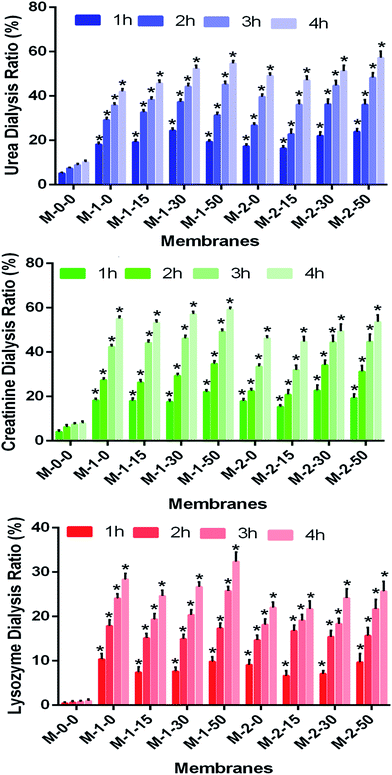 | ||
| Fig. 12 The dialysis clearance percentage of urea, creatinine and lysozyme by PES based membranes (mean results of three independent experiments ± SD) (*). | ||
The low reduction rate of creatinine and lysozyme were observed for the “M-2” sulfonated membranes (M-2-15 to M-2-50) as compared to the M-1 series sulfonated membranes (M-1-15 to M-1-50). It might be possible that sulfonated membranes of M-2 series (M-2-15 to M-2-50) repelled the solutes to pass via the dialysis membranes as these membranes also depict the good repulsive effect towards the adsorption of proteins (see Fig. 8).
4 Conclusion
Blood coagulation processes restricted the application of PES membrane and caused the uremic solutes to retain inside the blood stream, which directly or indirectly influences the renal clearance. The eliminated quantity of uremic toxins via the HD membranes determined the efficiency of dialysis therapy. In this work, the addition of NCs and SPES based additives change the chemistry of PES membranes. Hydrogen bonding occurred, hydrophilicity increased, and sponge or tear shaped entities of PES membrane converted into long, regular finger-like channels as confirmed by FTIR, CA and FESEM experiments, respectively. The MWCO of sulfonated membranes was reduced from >75k Da to less than 60k Da which is the basic requirement of high flux HD membranes. The increasing quantity of SPES polymer from 15 to 50% polymer weight in the membrane compositions directly influenced the membrane biocompatibility which not only improved the clotting time of blood but also reduced the protein adsorption and red blood cell destruction. The results revealed that combined methods; sulfonation of the PES and the use NCs increased the clearance percentage of uremic solutes and creatinine, lysozyme and urea and also improved the flux rate compared to the un-modified PES membranes.References
- L. Ma, B. Su, C. Cheng, Z. Yin, H. Qin, J. Zhao, S. Sun and C. Zhao, J. Membr. Sci., 2014, 470, 90–101 CrossRef CAS.
- S. K. Bowry, E. Gatti and J. Vienken, Contrib. Nephrol., 2010, 173, 110–118 Search PubMed.
- G. R. Matzke, G. R. Aronoff, A. J. Atkinson, W. M. Bennett, B. S. Decker, K.-U. Eckardt, T. Golper, D. W. Grabe, B. Kasiske and F. Keller, Kidney Int., 2011, 80, 1122–1137 CrossRef CAS PubMed.
- C. S. Zhao, J. M. Xue, F. Ran and S. D. Sun, Prog. Mater. Sci., 2013, 58, 76–150 CrossRef CAS.
- M. Sun, Y. Su, C. Mu and Z. Jiang, Ind. Eng. Chem. Res., 2009, 49, 790–796 CrossRef.
- B. Fang, Q. Ling, W. Zhao, Y. Ma, P. Bai, Q. Wei, H. Li and C. Zhao, J. Membr. Sci., 2009, 329, 46–55 CrossRef CAS.
- S. Nie, J. Xue, Y. Lu, Y. Liu, D. Wang, S. Sun, F. Ran and C. Zhao, Colloids Surf., B, 2012, 100, 116–125 CrossRef CAS PubMed.
- A. Higuchi, K. Shirano, M. Harashima, B. O. Yoon, M. Hara, M. Hattori and K. Imamura, Biomaterials, 2002, 23, 2659–2666 CrossRef CAS PubMed.
- A. De La Zerda, C. Zavaleta, S. Keren, S. Vaithilingam, S. Bodapati, Z. Liu, J. Levi, B. R. Smith, T.-J. Ma and O. Oralkan, Nat. Nanotechnol., 2008, 3, 557–562 CrossRef CAS PubMed.
- S. Pekker, J.-P. Salvetat, E. Jakab, J.-M. Bonard and L. Forro, J. Phys. Chem. B, 2001, 105, 7938–7943 CrossRef CAS.
- J. L. Bahr, J. Yang, D. V. Kosynkin, M. J. Bronikowski, R. E. Smalley and J. M. Tour, J. Am. Chem. Soc., 2001, 123, 6536–6542 CrossRef CAS PubMed.
- D. Qian, E. C. Dickey, R. Andrews and T. Rantell, Appl. Phys. Lett., 2000, 76, 2868–2870 CrossRef CAS.
- V. Vatanpour, S. S. Madaeni, R. Moradian, S. Zinadini and B. Astinchap, J. Membr. Sci., 2011, 375, 284–294 CrossRef CAS.
- H. Wang, T. Yu, C. Zhao and Q. Du, Fibers Polym., 2009, 10, 1–5 CrossRef.
- H. Wang, L. Yang, X. Zhaq, T. Yu and Q. Du, Chin. J. Chem. Eng., 2009, 17, 324–329 CrossRef CAS.
- L. Li, C. Cheng, T. Xiang, M. Tang, W. Zhao, S. Sun and C. Zhao, J. Membr. Sci., 2012, 405, 261–274 CrossRef.
- S. Nie, M. Tang, Z. Yin, L. Wang, S. Sun and C. Zhao, Biomater. Sci., 2014, 2, 98–109 RSC.
- Y. Cheng, W. Li, X. Fan, J. Liu, W. Xu and C. Yan, Electrochim. Acta, 2013, 111, 635–641 CrossRef CAS.
- D. Lu, H. Zou, R. Guan, H. Dai and L. Lu, Polym. Bull., 2005, 54, 21–28 CrossRef CAS.
- M. Irfan, A. Idris, N. M. Yusof, N. F. M. Khairuddin and H. Akhmal, J. Membr. Sci., 2014, 467, 73–84 CrossRef CAS.
- G.-X. Chen, H.-S. Kim, B. H. Park and J.-S. Yoon, J. Phys. Chem. B, 2005, 109, 22237–22243 CrossRef CAS PubMed.
- N. R. Raravikar, L. S. Schadler, A. Vijayaraghavan, Y. Zhao, B. Wei and P. M. Ajayan, Chem. Mater., 2005, 17, 974–983 CrossRef CAS.
- A. Idris and I. Ahmed, J. Appl. Polym. Sci., 2008, 108, 302–307 CrossRef CAS.
- R. Huang, P. Shao, C. Burns and X. Feng, J. Appl. Polym. Sci., 2001, 82, 2651–2660 CrossRef CAS.
- C. M. Kee and A. Idris, Sep. Purif. Technol., 2010, 75, 102–113 CrossRef CAS.
- Microsoft Word – XEI 1.5 Manual_Release Candidate_doc – XEImagingSoftwareManual.pdf, http://research.fit.edu/nhc/documents/XEImagingSoftwareManual.pdf.
- A. Idris, I. Ahmed and M. Misran, Desalination, 2009, 249, 541–548 CrossRef CAS.
- F. Ran, S. Nie, W. Zhao, J. Li, B. Su, S. Sun and C. Zhao, Acta Biomater., 2011, 7, 3370–3381 CrossRef CAS PubMed.
- M. Tang, J. Xue, K. Yan, T. Xiang, S. Sun and C. Zhao, J. Colloid Interface Sci., 2012, 386, 428–440 CrossRef CAS PubMed.
- E. Fallahiarezoudar, M. Ahmadipourroudposht, A. Idris, N. M. Yusof, M. Marvibaigi and M. Irfan, J. Mater. Sci., 2016, 1–21 Search PubMed.
- N. H. A. Ngadiman, A. Idris, M. Irfan, D. Kurniawan, N. M. Yusof and R. Nasiri, J. Mech. Behav. Biomed. Mater., 2015, 49, 90–104 CrossRef CAS PubMed.
- A. Idris and L. K. Yet, J. Membr. Sci., 2006, 280, 920–927 CrossRef CAS.
- M. Keen, L. Lancaster and L. Binkley, ANNA co re curriculum for nephrology nursing, 1995, pp. 207–258 Search PubMed.
- C. Hamciuc, M. Bruma and M. Klapper, J. Macromol. Sci., Part A: Pure Appl.Chem., 2001, 38, 659–671 CrossRef.
- R. Guan, H. Zou, D. Lu, C. Gong and Y. Liu, Eur. Polym. J., 2005, 41, 1554–1560 CrossRef CAS.
- J.-H. Choi, J. Jegal and W.-N. Kim, J. Membr. Sci., 2006, 284, 406–415 CrossRef CAS.
- B. P. Tripathi, N. C. Dubey and M. Stamm, J. Membr. Sci., 2014, 453, 263–274 CrossRef CAS.
- B. P. Tripathi, T. Chakrabarty and V. K. Shahi, J. Mater. Chem., 2010, 20, 8036–8044 RSC.
- G. Chamoulaud and D. Bélanger, Langmuir, 2004, 20, 4989–4995 CrossRef CAS PubMed.
- H. Edwards, D. Brown, J. Dale and S. Plant, J. Mol. Struct., 2001, 595, 111–125 CrossRef CAS.
- H. T. Ham, Y. S. Choi and I. J. Chung, J. Colloid Interface Sci., 2005, 286, 216–223 CrossRef CAS PubMed.
- K. Balasubramanian and M. Burghard, Small, 2005, 1, 180–192 CrossRef CAS PubMed.
- R. Sepahvand, M. Adeli, B. Astinchap and R. Kabiri, J. Nanopart. Res., 2008, 10, 1309–1318 CrossRef CAS.
- W. Caminati, A. Dell'Erba, G. Maccaferri and P. G. Favero, J. Mol. Spectrosc., 1998, 191, 45–48 CrossRef CAS PubMed.
- N. Giri, R. Natarajan, S. Gunasekaran and S. Shreemathi, Arch. Appl. Sci. Res., 2011, 3, 624–630 CAS.
- M. Taniguchi, J. E. Kilduff and G. Belfort, J. Membr. Sci., 2003, 222, 59–70 CrossRef CAS.
- M. Taniguchi and G. Belfort, J. Membr. Sci., 2004, 231, 147–157 CrossRef CAS.
- C. Barth, M. Goncalves, A. Pires, J. Roeder and B. Wolf, J. Membr. Sci., 2000, 169, 287–299 CrossRef CAS.
- A. Idris, N. Mat Zain and M. Noordin, Desalination, 2007, 207, 324–339 CrossRef CAS.
- A. Idris, K. Y. Hew and M. K. Chan, Jurnal Teknologi, 2009, 67–76 Search PubMed.
- H. Alloul, T. Roques-Carmes, T. Hamieh, A. Razafitianamaharavo, O. Barres, J. Toufaily and F. Villiéras, Powder Technol., 2013, 246, 575–582 CrossRef CAS.
- F. Aldeek, C. Mustin, L. Balan, T. Roques-Carmes, M.-P. Fontaine-Aupart and R. Schneider, Biomaterials, 2011, 32, 5459–5470 CrossRef CAS PubMed.
- C. Van Oss, R. Good and M. Chaudhury, J. Colloid Interface Sci., 1986, 111, 378–390 CrossRef CAS.
- S. Niyogi, M. Hamon, H. Hu, B. Zhao, P. Bhowmik, R. Sen, M. Itkis and R. Haddon, Acc. Chem. Res., 2002, 35, 1105–1113 CrossRef CAS PubMed.
- H. Humes, W. Fissell and K. Tiranathanagul, Kidney Int., 2006, 69, 1115–1119 CrossRef CAS PubMed.
- W. R. Clark and D. Gao, J. Am. Soc. Nephrol., 2002, 13, S41–S47 CAS.
- M. Irfan and A. Idris, Mater. Sci. Eng., C, 2015, 56, 574–592 CrossRef CAS PubMed.
- K. S. M. Matsuda, High-Performance Membrane Dialyzers, 2011, vol. 173, pp. 11–22 Search PubMed.
- G. Yin, J.-C. Janson and Z. Liu, J. Membr. Sci., 2000, 178, 99–105 CrossRef CAS.
- A. Fujimori, H. Naito and T. Miyazaki, Artif. Organs, 1998, 22, 1014–1017 CrossRef CAS PubMed.
- D. Basmadjian, M. V. Sefton and S. A. Baldwin, Biomaterials, 1997, 18, 1511–1522 CrossRef CAS PubMed.
- K. Ishihara, T. Hasegawa, J. Watanabe and Y. Iwasaki, Artif. Organs, 2002, 26, 1014–1019 CrossRef CAS PubMed.
- W. Zhao, J. Huang, B. Fang, S. Nie, N. Yi, B. Su, H. Li and C. Zhao, J. Membr. Sci., 2011, 369, 258–266 CrossRef CAS.
- D. Möckel, E. Staude and M. D. Guiver, J. Membr. Sci., 1999, 158, 63–75 CrossRef.
- Y.-q. Wang, T. Wang, Y.-l. Su, F.-b. Peng, H. Wu and Z.-y. Jiang, J. Membr. Sci., 2006, 270, 108–114 CrossRef CAS.
- W. Lim, ASH Education Program Book, 2009, vol. 2009, pp. 233–239 Search PubMed.
- Y.-X. Wang, J. L. Robertson, W. B. Spillman Jr and R. O. Claus, Pharm. Res., 2004, 21, 1362–1373 CrossRef CAS.
- Y. Iwasaki, H. Yamato, T. Nii-Kono, A. Fujieda, M. Uchida, A. Hosokawa, M. Motojima and M. Fukagawa, J. Bone Miner. Metab., 2006, 24, 172–175 CrossRef CAS PubMed.
- G. Lesaffer, R. De Smet, N. Lameire, A. Dhondt, P. Duym and R. Vanholder, Nephrol., Dial., Transplant., 2000, 15, 50–57 CrossRef CAS.
- R. C. Vanholder, R. V. De Smet and S. Ringoir, Clin. Chem., 1992, 38, 1429–1436 CAS.
- B. D. Johnson, K. E. Kip, O. C. Marroquin, P. M. Ridker, S. F. Kelsey, L. J. Shaw, C. J. Pepine, B. Sharaf, C. N. B. Merz and G. Sopko, Circulation, 2004, 109, 726–732 CrossRef CAS PubMed.
- G. Eknoyan, G. J. Beck, A. K. Cheung, J. T. Daugirdas, T. Greene, J. W. Kusek, M. Allon, J. Bailey, J. A. Delmez and T. A. Depner, N. Engl. J. Med., 2002, 347, 2010–2019 CrossRef PubMed.
- S. Acchiardo, A. Kraus Jr and B. Jennings, Am. J. Kidney Dis., 1989, 13, 70 CrossRef CAS PubMed.
| This journal is © The Royal Society of Chemistry 2016 |

